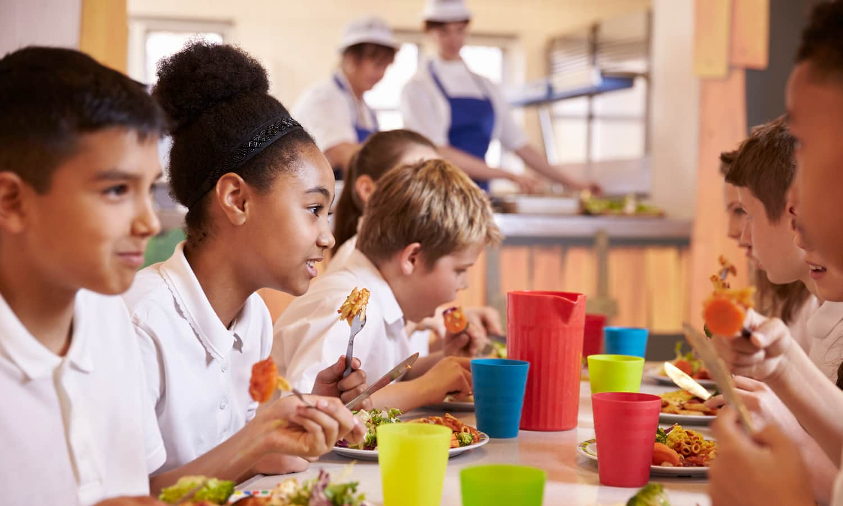At least 124,000 U.S. public and private schools have closed in response to the novel coronavirus outbreak. In some states, schools will remain closed through the end of the academic year. Amidst the transition to remote learning, school officials are taking unprecedented steps to ensure students have enough to eat.
Each day, nearly 30 million children in the United States depend on school food services and over 20 million qualify for low-cost or free meals. The National School Lunch Program is the second largest anti-hunger effort in the country behind the Supplemental Nutrition Assistance Program (SNAP) and accounts for nearly half of participating students’ recommended daily calorie intake, according to the American Journal of Preventive Medicine.
To keep student nutrition on track, some districts are using a special waiver issued by the United States Department of Agriculture (USDA) to modify the Summer Food Service Program and offer grab-and-go meals. Under this plan, families can pick up packaged meals on behalf of their children at school and in other non-congregate settings. Cities nation-wide are adopting this model, including New York, Los Angeles, Chicago, Atlanta, and Cleveland.
To accommodate large crowds while adhering to physical distancing guidelines, schools are transforming outdoor spaces into emergency meal distribution sites. Some schools are able to utilize their parking lots, while others rely on community organizations and public parks. In New York City, home to the largest school district in the country, the Department of Education now offers three free meals daily at more than 400 meal hubs across the city. This program is available to any New York resident, regardless of age.
In metropolitan areas where public transportation is more widely accessible, the grab-and-go model offers support for food-insecure families. But some advocacy groups argue that this approach overlooks students unable to leave home. In a recent press release, the Urban School Food Alliance called for lessening restrictions on meal delivery options to accommodate families with limited mobility.
For households where primary caregivers are elderly, self-isolating, or unable to work from home, commuting to pick up meals for students is not always a viable option. In rural communities, where students typically travel greater distances to reach schools and often lack access to reliable public transportation, the grab-and-go option also falls short.
To address this issue, some school districts are delivering meals to students at home. In Southern San Juan County of rural Utah, school bus drivers may travel over an hour to deliver meals daily. Districts in states such as Alaska, Minnesota, and Oregon are also mobilizing food access efforts by bus.
Facilitating these new efforts often requires support from a large network of volunteers. According to Megan Beck, Food Service Director for the Guilderland Central School District (GCSD) in Upstate New York, volunteers prepare and deliver meals to nearly 1,000 students twice per week. “The outpouring…[of] support that the community has shown our food service program has been incredible,” Beck tells Food Tank.
As the need for emergency food service grows, school staff and volunteers must contend with the possibility of exposure on a daily basis. Districts like GCSD have instilled strict physical distancing guidelines and are providing masks and gloves for all. But even with safety measures in place, Beck anticipates some setbacks for school food services in the long term. “As [the pandemic] continues on, the stress and anxiety levels for many will start to rise…I [expect] we will see many volunteers begin to back off and stay home,” Beck tells Food Tank.
In addition to volunteer attrition, policy stipulations and budgetary issues are also complicating school officials’ efforts to keep food service operations running, according to the School Nutrition Association. Support from private organizations is needed to fund the cost of transportation, protective gear, overtime pay for staff, and expanding services to include entire families.
Several nonprofit organizations and private companies are already assisting with emergency feeding efforts. In Pittsburgh, three nonprofits teamed up with local restaurants to distribute over 500 meals to students at their neighborhood bus stops. In Ohio, Panera Bread is working with the Children’s Hunger Alliance and the USDA to provide meals to children in need. A partnership between the Baylor Collaborative on Hunger and Poverty, McLane Global, and PepsiCo aims to deliver 1 million meals per week to students in rural Texas.
While many aspects of the typical school day have changed, students can still count on regular nutritious meals, Beck tells Food Tank. “Our priority is to make sure…any child in the district that is in need gets a meal.”





